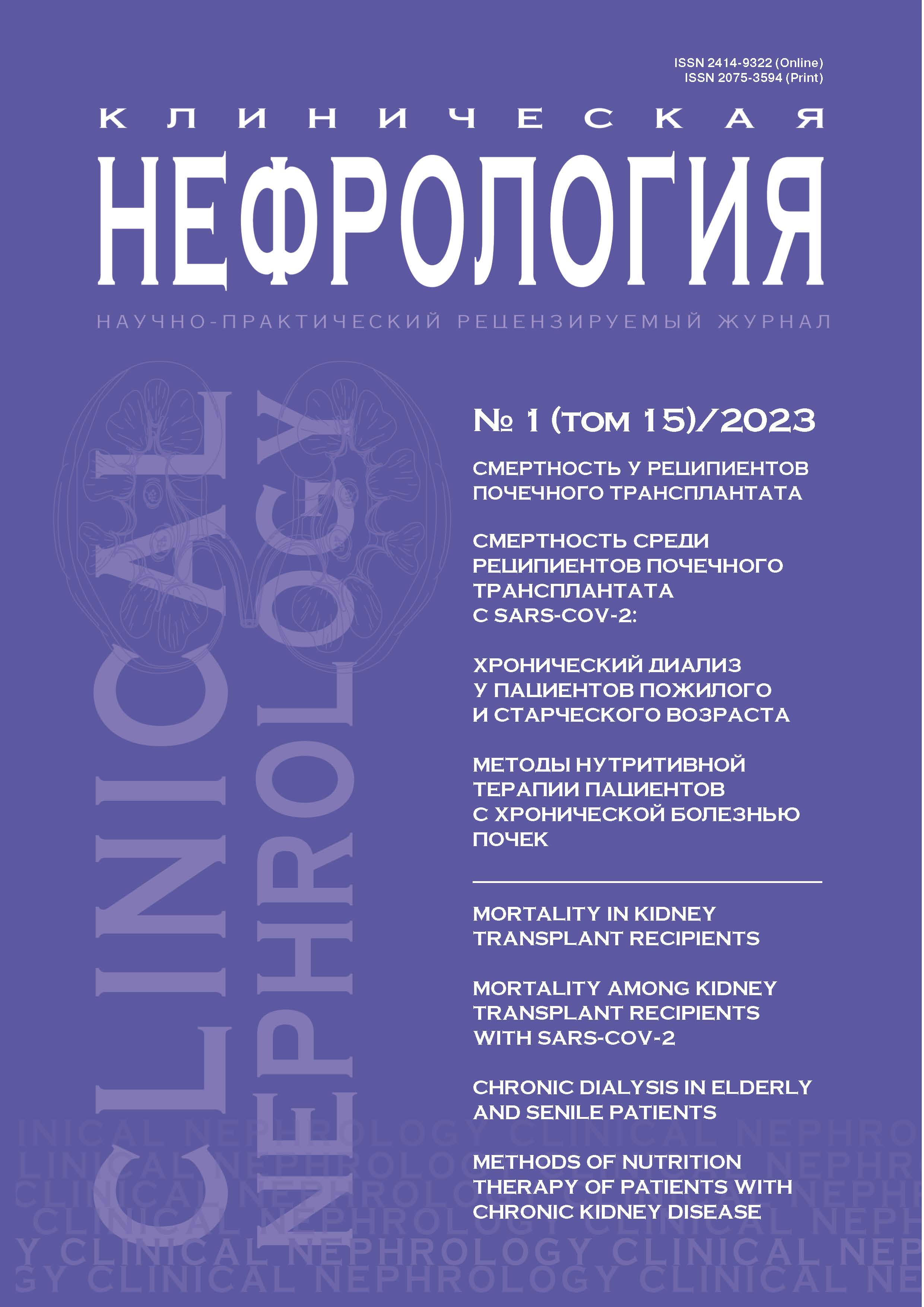Ранние предикторы поражения почек у детей и подростков с сахарным диабетом 1 типа
- Авторы: Зейнебекова А.Б.1,2, Умарова А.М.1,3, Усманова Д.У.1, Тұрқара А.М.1, Ковальчук В.Е.1, Дюсенова С.Б.1
-
Учреждения:
- НАО «Медицинский Университет»
- КГП «Поликлиника № 5»
- ДКДЦ «ТОО МФ Гиппократ»
- Выпуск: Том 15, № 1 (2023)
- Страницы: 54-57
- Раздел: Оригинальные статьи
- Статья опубликована: 20.05.2023
- URL: https://journals.eco-vector.com/2075-3594/article/view/430429
- DOI: https://doi.org/10.18565/nephrology.2023.1.54-57
- ID: 430429
Цитировать
Полный текст
Аннотация
Актуальность. В данной работе приведено наблюдения гипергликемического состояния с поражением почек у детей и подростков. Сахарный диабет 1 типа (СД1) вызван генетическими дефектами, которые наследуются по аутосомно-доминантному типу, поэтому в семьях пациентов, как правило, встречается более одного случая этой патологии.
Цель исследования: определить структуру патологии почек и обосновать клинико-лабораторные предикторы хронической болезни почек у детей и подростков с СД1.
Материал и методы. Проведен ретроспективный анализ историй болезней 109 детей и подростков с СД1 с поражением почек и дефицитом витамина D. Пациенты подразделены на две группы: основная группа – 75 пациентов с диабетической нефропатией (ДН) и с дефицитом витамина D, в контрольную группу вошли 34 пациента с ДН с нормальными показателями витамина D.
Верификация диагноза ДН проведена в стационаре и включила сбор и оценку жалоб, изучение анамнеза, клиническое обследование пациента, оценку самоконтроля по уровню гликогемоглобина, измерение артериального давления, лабораторное исследование: общий белок, креатинин и мочевина крови, общий анализ мочи на наличие протеинурии, суточный анализ мочи на альбуминурию, скорость клубочковой фильтрации (СКФ); ультразвуковое исследование почек. Все пациенты были проконсультированы нефрологом и эндокринологом.
Результаты. Выявлено, что на ранних стадиях выявить ДН невозможно, т.к. ранним методом диагностики ДН признано выявление альбуминурии (последняя обратимая стадия ДН). Детям на ранних стадиях было проведено корректное и своевременное лечение инсулинотерапией, что повлияло на предотвращение развития ДН.
Заключение. Таким образом, одновременная оценка основных показателей – СКФ и альбуминурии – необходима для первичной диагностики ренальной дисфункции, а также для контроля терапии, скорости прогрессирования патологического процесса и определения прогноза.
Ключевые слова
Полный текст
Об авторах
Амина Бакыткызы Зейнебекова
НАО «Медицинский Университет»; КГП «Поликлиника № 5»
Автор, ответственный за переписку.
Email: zeynebekova97@mail.ru
ORCID iD: 0000-0001-8949-3283
резидент кафедры педиатрии и неонатологии Медицинского университета Караганды, участковый врач КГП «Поликлиника № 5» Караганды Минздрава Республики Казахстан
Казахстан, Караганда; КарагандаАйжанна Мухтаровна Умарова
НАО «Медицинский Университет»; ДКДЦ «ТОО МФ Гиппократ»
Email: zeynebekova97@mail.ru
ORCID iD: 0000-0003-3201-9040
резидент кафедры педиатрии и неонатологии Медицинского университета Караганды Минздрава Республики Казахстан, врач-педиатр ДКДЦ ТОО МФ «Гиппократ»
Казахстан, Караганда; КарагандаДилера Улугбеккызы Усманова
НАО «Медицинский Университет»
Email: zeynebekova97@mail.ru
ORCID iD: 0000-0001-9550-9819
резидент кафедры педиатрии и неонатологии Медицинского университета Караганды Минздрава Республики Казахстан
Казахстан, КарагандаАйдана Мейрамханқызы Тұрқара
НАО «Медицинский Университет»
Email: zeynebekova97@mail.ru
ORCID iD: 0000-0001-6963-4747
резидент кафедры педиатрии и неонатологии Медицинского университета Караганды Минздрава Республики Казахстан
Казахстан, КарагандаВиктория Евгеньевна Ковальчук
НАО «Медицинский Университет»
Email: zeynebekova97@mail.ru
ORCID iD: 0000-0002-8385-644X
резидент кафедры педиатрии и неонатологии Медицинского университета Караганды Минздрава Республики Казахстан
Казахстан, КарагандаСандугаш Болатовна Дюсенова
НАО «Медицинский Университет»
Email: zeynebekova97@mail.ru
ORCID iD: 0000-0001-9667-0735
д.м.н., профессор кафедры педиатрии и неонатологии Медицинского Университета Караганды Минздрава Республики Казахстан
Казахстан, КарагандаСписок литературы
- Иманова Ж., Айкенова Ж., Орынбасарулы А. Сахарный диабет и как его предупредить?[Internet] [Imanova Zh., Aikenova Zh., Orynbasaruly A. Diabetes mellitus and how to prevent it? (In Russ).]. Доступно по: http://www.rcrz.kz/index.php/ru/2017-03-12-10-50-44/press-reliz/2237-sakharnyj-diabet-kak-ego-predupredit. Ссылка активна на 22.04.2021.
- Раздолькина Т.И. Особенности хронической почечной недостаточности у детей. Трудный пациент. 2013;11 [Razdolkina T.I. Features of chronic renal failure in children. Trudn. pacient. 2013;11 (In Russ.)]. Доступно по: https://t-pacient.ru/wp-content/uploads/2013/11/TP-2-3-2013.pdf
- Савельева Е.В. Клинико-лабораторная характеристика заболеваний почек при сахарном диабете 1 типа у детей: Дисс. канд. мед. наук. Оренбург, 2008. [Saveleva E.V. Clinical and laboratory characteristics of kidney diseases in type 1 diabetes mellitus in children: [dissertation]. Orenburg, 2008 (In Russ.)]. Доступно по: https://www.dissercat.com/content/kliniko-laboratornaya-kharakteristika-zabolevanii-pochek-pri-sakharnom-diabete-1-go-tipa-u-d. https://www.invitro.ru/ [интернет]. Скорость клубочковой фильтрации расчетная, по формуле Шварца (креатинин) для детей (рСКФ по формуле Шварца, 2009; estimated Glomerular Filtration Rate, eGFR for children, Schwartz 2009, «bedside» Schwartz equation). Доступно по: https://www.invitro.ru/analizes/for-doctors/belgorod/2368/61359
- Аверьянов С.Н. и др. Определение скорости клубочковой фильтрации у детей: история и современные подходы. Педиатрическая фармакология. 2018;15(3):218–23. [Averyanov S.N., et al. Determination of glomerular filtration rate in children: history and modern approaches. Pediatric pharmacology. 2018;15(3):218–23 (In Russ.)]. Доступно по: https://doi.org/10.15690/pf.v15i3.1901
- KDIGO, 2012. Clinical Practice Guideline for the Evaluation and Management of Chronic Kidney Dis. Kidney Int. 2013;3(1). Available at https://kdigo.org/wp-content/uploads/2017/02/KDIGO_2012_CKD_GL.pdf
- Schwartz G.J., et al. New equations to estimate GFR in children with CKD. J. Am. Soc. Nephrol. 2009;20(3):629–37. Doi: https://doi.org/10.1681/ASN.2008030287.
- Волкова А.А., Зорин И.В., Чеснокова С.А., Плотникова С.В. Хроническая болезнь почек у детей. Нефрология. 2019;23(5). [Volkova A.A., Zorin I.V., Chesnokova S.A., Plotnikova S.V. Chronic kidney disease in children. Nephrol. 2019;23(5) (In Russ.)]. Doi: https://doi.org/10.24884/1561-6274-2019-23-5-29-46.
- Национальные рекомендации. Хроническая болезнь почек: основные принципы скрининга, диагностики, профилактики и подходы к лечению. [National recommendations. Chronic kidney disease: basic principles of screening, diagnosis, prevention and treatment approaches (In Russ.)]. Доступно по: Doi: http://www.nephro.ru/content/files/standards/ckdru.pdf.
- Алымбаев Э.Ш., Терехова О.И., Маймерова Г.Ш., Кожоназарова Г.К. Диабетическая нефропатия у детей и подростков в Киргизской Республике. Бюлл. науки и практики. 2019;5(4). [Alymbayev E.Sh., Terekhova O.I., Mammadova G.Sh., Kozhonazarova G.K. Diabetic nephropathy in children and adolescents in the Kyrgyz Republic. Bull. Sci. Pract. 2019;5(4) (In Russ.)]. Doi: https://doi.org/10.33619/2414-2948/41/18.
- Казакова В.Л., Лукушкина Е.Ф., Строгин Л.Ф., Азова Е.А. Диабетическая нефропатия и изменения миокарда у детей с сахарным диабетом 1 типа. Сахарный диабет.2009;12(3). [Kazakova V.L., Lukushkina E.F., Strongin L.F., Azova E.A. Diabetic nephropathy and myocardial changes in children with type 1 diabetes mellitus. Diab. Mellit. 2009;12(3). (In Russ.)]. Doi: https://doi.org/10.14341/2072-0351-5451.
Дополнительные файлы








